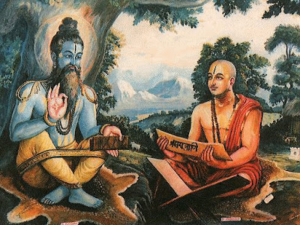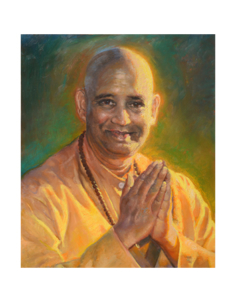The Glory of Guru

Insights into Spiritual Practice
Guru Purnima falls during the full moon or “purnima” of the Hindi month Ashadha (corresponding to July). This day is very sacred for spiritual seekers, aspirants, and sanyasins (those who have adopted a religious order of renunciation). It commemorates the birth of Sage Vyasa, one of the greatest sages of the past, who is considered a part incarnation of the Lord Vishnu.
Many centuries before Christ, Sage Vyasa appeared on this earth as the son of Sage Parashara. Devoting his life to the practice of austerity and meditation, he preserved and promoted the teachings of the Vedas, compiled the Vedas, wrote eighteen Puranas, wrote the voluminous work of the Mahabharata (of which the Gita is a small portion), composed the Brahma Sutras (aphorisms of Vedanta philosophy), and wrote commentaries on various other scriptures. Humanity will be eternally indebted to this sage for his literary, religious, and philosophical contributions.
On the day of Guru Purnima, aspirants adore their guru as the living manifestation of Vyasa. Sanyasins that normally spend their lives wondering will settle down during the rainy season, and devote their time to the serious study of the Gita, Upanishads, and Brahma Sutras. They begin their study on this auspicious day which coincides with the approximate time when the monsoon rains begin in India, and continue for four months, until the rains terminate.
On Guru Purnima, aspirants also become especially aware of the glorious tradition of the guru-shishya relationship. One sees how his own guru leads him to the glorious chain that emanated from Lord Vishnu himself, and He worships all the Brahma Vidya gurus (spiritual preceptors) who taught the mystic science of attaining intuitional wisdom.
The goal of Yoga is to discover one’s essential nature through integrating the four aspects one’s personality – actions, emotions, will, and reason. Through persistent and sincere practice, this process of spiritual evolution leads one to realize that there is no separation between oneself and the perceived world. In Yoga philosophy, the Guru facilitates a successful achievement of this objective. Just as a person with poor eyesight is unable to behold the splendor of a majestic natural vista, an aspirant is unable to clearly formulate a mental picture and pathway of successful attainment of the goal without the guidance of Guru. The Sanskrit term Guru literally signifies, “He who illumines the cave of the heart.” “Gu” means “cave” and “ru” means to illumine.
Raja Yoga of Patanjali Maharshi teaches that God is the Guru of Gurus, the Supreme Guru. But since a human being is unable to comprehend the Divine Self until his mind is highly advanced, a spiritual preceptor is needed. That guide is the Guru – one who, through his intuitive understanding, has experienced the revelation of the oneness of all existence. The Guru is like a bridge from the aspirant’s conditioned mind to Absolute Consciousness.
A Storehouse of Secrets
Guru Purnima marks the commencement of a profound undertaking by sincere aspirants – the study of the scriptures. Moreover, the Hindu scriptures contain profound secrets of life and the ancient wisdom of the Vedas have been presented time and time again through the various writings of sages. Though the wisdom remains the same, it is presented in different forms to suit the changing times. Thus, through a long process of mental and philosophical evolution, these scriptures have become a unique treasure trove of knowledge.
The mysteries of the mind, the secrets of psychology and parapsychology, the way to health and vitality, the art of reflection and inquiry, the science of meditation and samadhi (super consciousness), the techniques of developing psychic powers, and the secrets of attaining enlightenment are all well preserved in the scriptures. Therefore, an aspirant must practice swadhyaya (devout study of the scriptures) in order to be aware of the vast treasure of wisdom he has inherited from his forefathers.
The Spiritual Message
The scriptures outline the following points which must be practiced and emulated by an aspirant in order to enhance and enrich his life:
1) Do not be contented with a mere change in your personality. Learn the art of being transformed into a spiritually enlightened person.
You have been constantly changing from time to time and from birth to birth. Yet in this process of continuous change, your negative traits often continue to exist though they may remain hidden behind different masks. When you become transformed however, those negative traits are completely eradicated. As a result, instead of masking your anger, hatred, and pride, you eliminate these negative qualities and become adorned with understanding, love, and humility.
As a child you played with toys. As a grown-up, though your toys may have changed, your childish nature often continues. When the art of transformation is learned, one outgrows this childish nature and views the world with a spiritual vision.
2) Amass a wealth of divine impressions. With a changed vision you are able to recognize a spiritual basis, a Divine Hand underlying every development in life, and behind every name and form that you encounter. As this vision grows, you draw impressions of Divine love, understanding, contentment, peace, harmony, joyousness, fearlessness, humility, and magnanimity into your unconscious.
No matter what circumstances may arise, your mind will become increasingly sensitive to positive impressions alone; it repels negative impressions of hatred, anger, pride, fear, and others. And as these impressions of the unconscious become positive, your whole personality undergoes a transformation – you are gradually transformed into a Divine being.
3) Develop mahat bhavana (elevated attitude). Do not allow degraded feelings to rule your heart. Instead of developing the feeling, “I am a miserable personality, a mortal being subject to many limitations,” try to think and feel, “I am essentially Divine. I am the non-dual Absolute.” Change your attitude towards your own self and assert your Divine identity.
Similarly, when you come into contact with others, you should not emit any degraded sentiments. Every human being is a saint in the making. Essentially everyone is Divine. Therefore, learn the art of recognizing and encouraging the positive elements in every personality. In so doing, you become a center of joy and inspiration to others.
4) Learn the art of meditation, reflection, inquiry, and loving remembrance of the Divine Self. Seek guidance from a spiritual preceptor. Moreover, let this whole world become your guru. As you advance spiritually, you will become sensitive to the lessons of life and discover “sermons in stones and lessons in running brooks.”
5) Live a balanced and rhythmic life. Plan your daily life and utilize your time in such a manner that you can practice a blend of meditation, reflection, study of scriptures, loving remembrance of God, performance of daily duties, and some form of selfless service to humanity. Do not let time pass in vain. A day lived without remembrance of the Divine Self, the practice of meditation, or study of an elevating scripture, is a day lived in vain.
Let us celebrate Guru Purnima by living a life rooted in Yoga. With Guru’s grace, march on the path of righteous conduct. Thus guided by the nectarine teachings of the Vedic scriptures, unfold your talents, utilize your spiritual resources, and attain enlightenment even in this very incarnation. May you receive the blessings of the sages and saints, and as the moon bathes the earth with its nectarine rays, may you bathe the earth with the luminous raise of your wisdom!
 May God Bless You! Hari OM Tat Sat!
May God Bless You! Hari OM Tat Sat!

